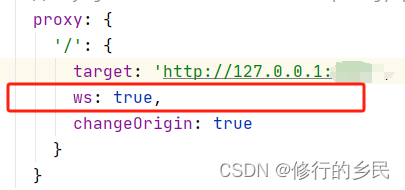第一步、首先需要安装组件
yarn add stompjs
yarn add sockjs-client
安装完成后,(package.json)文件出现下面代码:

第二步,前端增加代理配置
(vue.config.js)文件中

使用 ws: true, 支持websocket
第三步、后端增websocket依赖
pom.xml文件中
<dependency>
<groupId>org.springframework.boot</groupId>
<artifactId>spring-boot-starter-websocket</artifactId>
</dependency>第四步、后端配置消息代理
使用spring自带的WebSocketMessageBrokerConfigurer
import org.springframework.beans.factory.annotation.Value;
import org.springframework.context.annotation.Configuration;
import org.springframework.messaging.simp.config.MessageBrokerRegistry;
import org.springframework.web.socket.config.annotation.*;
@Configuration
@EnableWebSocketMessageBroker
public class WebSocketConfig implements WebSocketMessageBrokerConfigurer {
@Override
public void registerStompEndpoints(StompEndpointRegistry registry) {
// 注册消息监听端点,使用SockJS协议
StompWebSocketEndpointRegistration registration = registry.addEndpoint("/stompPoint");
registration.setAllowedOriginPatterns("*");
registration.withSockJS();
}
@Override
public void configureMessageBroker(MessageBrokerRegistry registry) {
if (enable) {
// 启用消息代理
registry.enableStompBrokerRelay("/msgOneTopic").setRelayHost(host)
.setRelayPort(port).setSystemHeartbeatReceiveInterval(5000)
.setSystemHeartbeatSendInterval(5000);
} else {
registry.enableSimpleBroker("/topic","/retMsg");
}
}
}第五步、前端连接并监听
需要注意监听的端点,和后端注册的端点一致
<template>
<div class="websocket"></div>
</template>
<script>
import SockJS from 'sockjs-client'
import Stomp from 'stompjs'
import {mapActions, mapGetters, mapMutations, mapState} from 'vuex'
export default {
data() {
return {
socketUrl: '/stompPoint',
socket: null,
stompClient: null,
timer: null,
}
},
mounted() {
this.initWebSocket()
},
destroyed() {
// 页面离开时断开连接,清除定时器
this.disconnect();
clearInterval(this.timer);
},
computed: {
},
methods: {
initWebSocket() {
// 建立连接对象
this.socket = new SockJS(socketUrl)
// 获取STOMP子协议的客户端对象
this.stompClient = Stomp.over(this.socket)
// 向服务器发起websocket连接
this.stompClient.connect({}, (message) => {
console.log("-----------------连接成功-----------------")
console.log(message);
// 连接成功
this.successCallback();
}, error => {
console.log("-----------------连接失败-----------------")
console.log(error)
this.reconnect(this.socketUrl, this.successCallback)
})
},
// 连接成功
successCallback() {
this.stompClient.subscribe('/topic/msgOneTopic', (msg) => {
const receivedMsg = JSON.parse(msg.body)//接收服务端信息
console.info("-------------successCallback---消息-------------");
console.info(receivedMsg)
//下面就可以根据从后端接收到消息干事情了
})
},
reconnect(socketUrl, successCallback) {
console.info('-----------------开始重新连接WebSocket-----------------')
setTimeout(() => {
this.socket = new SockJS(socketUrl)
this.stompClient = Stomp.over(this.socket)
this.stompClient.connect({}, (frame) => {
console.info("-----------------重新连接WebSocket成功-----------------")
console.info(frame);
// 连接成功,清除定时器
successCallback()
}, error => {
console.info("-----------------重新连接WebSocket成功-----------------")
console.info(error);
this.reconnect(socketUrl, successCallback);
})
}, 10000)
},
// 断开连接
disconnect() {
if (this.stompClient != null) {
this.stompClient.disconnect()
}
}
}
}
</script>
<style lang="less" scoped>
</style>第六步、后端发送消息
@Service("webSocketService")
public class WebSocketService {
@Autowired
private SimpMessagingTemplate simpMessagingTemplate;
public void sendMsg() throws Exception {
String destination = "/msgOneTopic";
simpMessagingTemplate.convertAndSend(destination, "测试信息");
}
}第七步、前端增加处理逻辑
上面第五步中,successCallBack中继续增加我们需要的业务逻辑





















 319
319











 被折叠的 条评论
为什么被折叠?
被折叠的 条评论
为什么被折叠?








